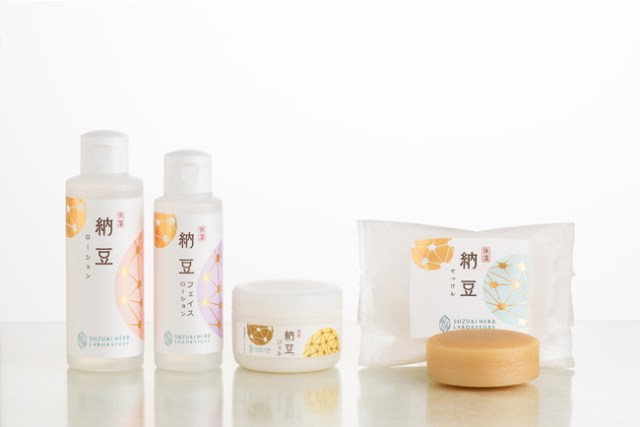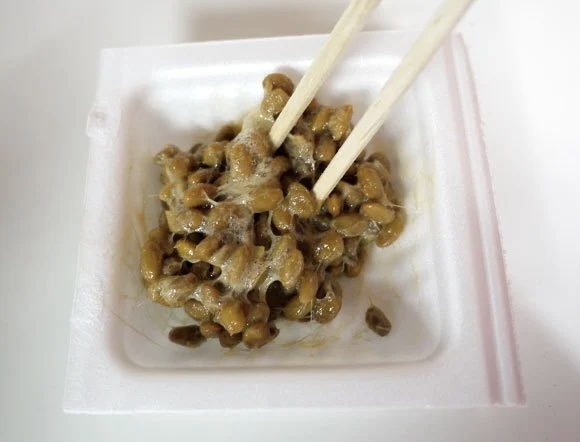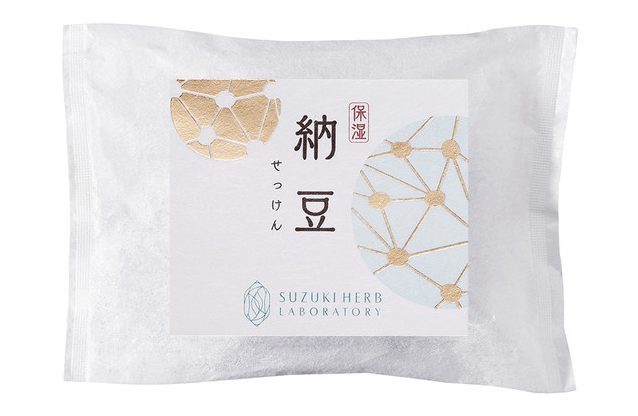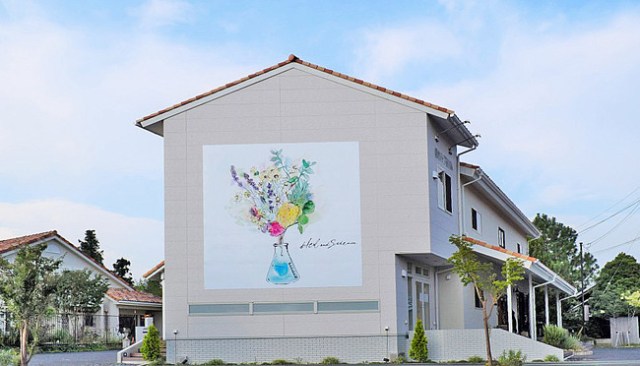
Make your skin as fresh as a styrofoam tub of fermented beans!
Many people are not too crazy about the fermented soy beans known as “natto” in Japan, what with their aged-cheese-like smell. For me, however, it’s the texture that makes me want to gag every time, with a fibrous sliminess similar to okra or yamaimo, and an overall mouthfeel of regurgitated beetles.

And yet despite the revulsion that feeling creates in my mouth, I could see that very same texture working very well as a lotion or soap. So a new line of soaps made with natto-derived ingredients and aptly named Natto, makes a lot of sense.
Of course, none of these products will leave you smelling like natto because the chemicals responsible for that notorious scent are not included in Natto. Instead the products are all based on polyglutamic acid, which is the substance responsible for natto’s stringy goo.
▼ Natto Face Soap
Natto also includes “natto gum,” a substance which also goes by the name “shokubutsusei collagen” or “vegetable collagen”. Vegetables don’t actually contain collagen and neither does natto, but natto gum is given that nickname because its effect on moisturizing skin is said to rival that of actual collagen.
There’s a bunch of other good stuff in Natto as well, such as fermented soy milk liquid, hyaluronic acid, and even the extract of natto’s gooey cousin okra. It comes in four forms: Natto Face Soap, Natto Body Lotion, Natto Face Lotion, and Natto Gel.
▼ Natto Gel
In addition to the smell, these items differ from real natto in that they do not leave a sticky feeling and penetrate deep into the skin for effective moisturization. The Natto line is made by Suzuki Herb Laboratory in Tokai Village, Ibaraki Prefecture, which is famous in Japan as a leading producer of natto and takes great pride in it. The products were developed a few years ago and mostly sold locally or through the Suzuki Herb Laboratory website.
▼ Suzuki Herb Laboratory
But for one day only they will also be sold at the Ibaraki Sense store in the Ginza area of Chuo, Tokyo on 17 July. It’s surprising they didn’t choose the previous Sunday of 10 July, which is frequently referred to as Natto Day because the numbers “7” and “10” together can kind of be read as “na-to.”
It seems that even the most sacred day of natto can’t beat the foot traffic of a long weekend, but don’t let that stop you from slathering on some of the amazingly healthy effects of natto on your skin. Even though you’ll never catch me eating it, I’m more than willing to give it a try on these sunburns I’ve been nursing.
Source: PR Times
Images: PR Times (Unless otherise noted)
● Want to hear about SoraNews24’s latest articles as soon as they’re published? Follow us on Facebook and Twitter!




 Natto Boys want to take their smelly beans to Africa, but they need your help
Natto Boys want to take their smelly beans to Africa, but they need your help Our natto maniac verifies the legitimacy of fermented soybean-flavored potato chips【Taste test】
Our natto maniac verifies the legitimacy of fermented soybean-flavored potato chips【Taste test】 We spice up our fermented soybeans with curry powder flavored natto【Taste Test】
We spice up our fermented soybeans with curry powder flavored natto【Taste Test】 Mizkan develops world’s most “beautiful” natto, Mr. Sato takes it for a spin
Mizkan develops world’s most “beautiful” natto, Mr. Sato takes it for a spin Natto allergy is caused by jellyfish stings, says surprising Japanese study
Natto allergy is caused by jellyfish stings, says surprising Japanese study Red light district sushi restaurant in Tokyo shows us just how wrong we were about it
Red light district sushi restaurant in Tokyo shows us just how wrong we were about it McDonald’s new Happy Meals offer up cute and practical Sanrio lifestyle goods
McDonald’s new Happy Meals offer up cute and practical Sanrio lifestyle goods Pokémon Sleep camping suite and guestrooms coming to Tokyo Hyatt along with giant Snorlax burgers
Pokémon Sleep camping suite and guestrooms coming to Tokyo Hyatt along with giant Snorlax burgers Japanese ramen restaurants under pressure from new yen banknotes
Japanese ramen restaurants under pressure from new yen banknotes Sandwiches fit for a sumo served up in Osaka【Taste Test】
Sandwiches fit for a sumo served up in Osaka【Taste Test】 Historical figures get manga makeovers from artists of Spy x Family, My Hero Academia and more
Historical figures get manga makeovers from artists of Spy x Family, My Hero Academia and more Akihabara pop-up shop sells goods made by Japanese prison inmates
Akihabara pop-up shop sells goods made by Japanese prison inmates Anime girl English teacher Ellen-sensei becomes VTuber/VVTUber and NFT
Anime girl English teacher Ellen-sensei becomes VTuber/VVTUber and NFT Beautiful Red and Blue Star luxury trains set to be Japan’s new Hokkaido travel stars
Beautiful Red and Blue Star luxury trains set to be Japan’s new Hokkaido travel stars Wendy’s releases a Pretzel Roast Beef Burger aimed at foreign tourists in Japan
Wendy’s releases a Pretzel Roast Beef Burger aimed at foreign tourists in Japan All-you-can-drink Starbucks and amazing views part of Tokyo’s new 170 meter-high sky lounge
All-you-can-drink Starbucks and amazing views part of Tokyo’s new 170 meter-high sky lounge More foreign tourists than ever before in history visited Japan last month
More foreign tourists than ever before in history visited Japan last month French Fries Bread in Tokyo’s Shibuya becomes a hit on social media
French Fries Bread in Tokyo’s Shibuya becomes a hit on social media Studio Ghibli releases new action figures featuring Nausicaä of the Valley of the Wind characters
Studio Ghibli releases new action figures featuring Nausicaä of the Valley of the Wind characters New private rooms on Tokaido Shinkansen change the way we travel from Tokyo to Kyoto
New private rooms on Tokaido Shinkansen change the way we travel from Tokyo to Kyoto Starbucks reopens at Shibuya Scramble Crossing with new look and design concept
Starbucks reopens at Shibuya Scramble Crossing with new look and design concept Studio Ghibli glasses cases let anime characters keep an eye on your spectacles
Studio Ghibli glasses cases let anime characters keep an eye on your spectacles Beautiful Ghibli sealing wax kits let you create accessories and elegant letter decorations【Pics】
Beautiful Ghibli sealing wax kits let you create accessories and elegant letter decorations【Pics】 Studio Ghibli releases Kiki’s Delivery Service chocolate cake pouches in Japan
Studio Ghibli releases Kiki’s Delivery Service chocolate cake pouches in Japan New definition of “Japanese whiskey” goes into effect to prevent fakes from fooling overseas buyers
New definition of “Japanese whiskey” goes into effect to prevent fakes from fooling overseas buyers Our Japanese reporter visits Costco in the U.S., finds super American and very Japanese things
Our Japanese reporter visits Costco in the U.S., finds super American and very Japanese things Studio Ghibli unveils Mother’s Day gift set that captures the love in My Neighbour Totoro
Studio Ghibli unveils Mother’s Day gift set that captures the love in My Neighbour Totoro New Japanese KitKat flavour stars Sanrio characters, including Hello Kitty
New Japanese KitKat flavour stars Sanrio characters, including Hello Kitty New Pokémon cakes let you eat your way through Pikachu and all the Eevee evolutions
New Pokémon cakes let you eat your way through Pikachu and all the Eevee evolutions Disney princesses get official manga makeovers for Manga Princess Cafe opening in Tokyo
Disney princesses get official manga makeovers for Manga Princess Cafe opening in Tokyo Sales of Japan’s most convenient train ticket/shopping payment cards suspended indefinitely
Sales of Japan’s most convenient train ticket/shopping payment cards suspended indefinitely Sold-out Studio Ghibli desktop humidifiers are back so Totoro can help you through the dry season
Sold-out Studio Ghibli desktop humidifiers are back so Totoro can help you through the dry season Japanese government to make first change to romanization spelling rules since the 1950s
Japanese government to make first change to romanization spelling rules since the 1950s Ghibli founders Toshio Suzuki and Hayao Miyazaki contribute to Japanese whisky Totoro label design
Ghibli founders Toshio Suzuki and Hayao Miyazaki contribute to Japanese whisky Totoro label design Doraemon found buried at sea as scene from 1993 anime becomes real life【Photos】
Doraemon found buried at sea as scene from 1993 anime becomes real life【Photos】 Tokyo’s most famous Starbucks is closed
Tokyo’s most famous Starbucks is closed One Piece characters’ nationalities revealed, but fans have mixed opinions
One Piece characters’ nationalities revealed, but fans have mixed opinions We asked a Uniqlo employee what four things we should buy and their suggestions didn’t disappoint
We asked a Uniqlo employee what four things we should buy and their suggestions didn’t disappoint Princesses, fruits, and blacksmiths: Study reveals the 30 most unusual family names in Japan
Princesses, fruits, and blacksmiths: Study reveals the 30 most unusual family names in Japan New product stirs your natto 424 times to bring out its ultimate flavor
New product stirs your natto 424 times to bring out its ultimate flavor A pack of natto (fermented Japanese soybeans) a day keeps the death away according to study
A pack of natto (fermented Japanese soybeans) a day keeps the death away according to study Natto for beginners? How to half-make Japanese fermented soybeans at home【SoraKitchen】
Natto for beginners? How to half-make Japanese fermented soybeans at home【SoraKitchen】 We tried making natto the old-fashioned way, and the result was unexpected but delicious 【SoraKitchen】
We tried making natto the old-fashioned way, and the result was unexpected but delicious 【SoraKitchen】 New magic powder purports to make natto edible even for bean-haters
New magic powder purports to make natto edible even for bean-haters All-you-can-eat stinky fermented soybeans come to Ginza, if that’s your thing
All-you-can-eat stinky fermented soybeans come to Ginza, if that’s your thing We try a new natto coffee ice cream that took 17 months to perfect
We try a new natto coffee ice cream that took 17 months to perfect Instant natto soba a suspiciously hot item so we check it out
Instant natto soba a suspiciously hot item so we check it out We try ice cream with a topping of natto fermented soybeans, because the Internet told us to
We try ice cream with a topping of natto fermented soybeans, because the Internet told us to Pizza Hut’s sakura pizza takes cherry blossom season to weird places in Taiwan
Pizza Hut’s sakura pizza takes cherry blossom season to weird places in Taiwan Eat Japanese cuisine like an epicure with the updated Ultimate NTO natto mixer from Takara Tomy
Eat Japanese cuisine like an epicure with the updated Ultimate NTO natto mixer from Takara Tomy Toast with fermented soybeans and honey may not be good-looking, but it is good eating
Toast with fermented soybeans and honey may not be good-looking, but it is good eating Fermented soybean shaved ice pushes the envelope of summertime sweets
Fermented soybean shaved ice pushes the envelope of summertime sweets Custard pudding with natto fermented soybeans? We try the new dessert craze sweeping Japan
Custard pudding with natto fermented soybeans? We try the new dessert craze sweeping Japan There’s no reason not to play with your food with this natto in Nanoblock form
There’s no reason not to play with your food with this natto in Nanoblock form Rice made out of soybeans is coming
Rice made out of soybeans is coming Instant noodle company combines yakisoba noodles with fermented natto bean topping
Instant noodle company combines yakisoba noodles with fermented natto bean topping
Leave a Reply